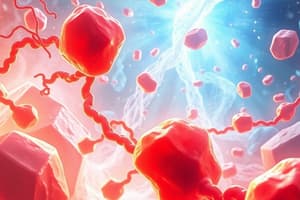Podcast
Questions and Answers
Which of the following lipids is NOT associated with apolipoproteins during transportation in the blood?
Which of the following lipids is NOT associated with apolipoproteins during transportation in the blood?
- Phospholipids
- Cholesterol esters
- Free fatty acids (correct)
- Triacylglycerol
What is the function of amphipathic lipids in lipoproteins?
What is the function of amphipathic lipids in lipoproteins?
- To bind to apolipoproteins
- To facilitate transportation in aqueous solutions (correct)
- To provide a hydrophobic core
- To regulate lipid metabolism
What is the main difference between peripheral and integral apoproteins?
What is the main difference between peripheral and integral apoproteins?
- Their ability to transfer between lipoproteins (correct)
- Their structure and composition
- Their ability to bind lipids
- Their function in lipoprotein metabolism
What is the central core of lipoproteins composed of?
What is the central core of lipoproteins composed of?
What is the term that describes a chemical compound possessing both hydrophilic and lipophilic properties?
What is the term that describes a chemical compound possessing both hydrophilic and lipophilic properties?
What is the role of apolipoproteins in lipoprotein metabolism?
What is the role of apolipoproteins in lipoprotein metabolism?
Which of the following is NOT a component of lipoproteins?
Which of the following is NOT a component of lipoproteins?
What is the orientation of the polar groups of phospholipids in lipoproteins?
What is the orientation of the polar groups of phospholipids in lipoproteins?
What is the main purpose of lipoproteins in the blood?
What is the main purpose of lipoproteins in the blood?
Which apolipoprotein is an example of an integral apolipoprotein?
Which apolipoprotein is an example of an integral apolipoprotein?
Study Notes
Lipoprotein Structure and Functions
- Apoproteins solubilize hydrophobic lipids and facilitate receptor recognition for receptor-mediated uptake of plasma lipoproteins by certain tissues.
- Apoproteins act as activators or coenzymes for enzymes involved in lipoprotein metabolism (e.g., apo C activates lipoprotein lipase, which degrades TG into unesterified fatty acids and glycerol).
Classification of Plasma Lipoproteins
- Lipoproteins are classified according to their densities, which are determined by the amount of TG (making them less dense) and apoproteins (making them more dense).
Types of Lipoproteins
- Chylomicron:
- Synthesized in the intestine after a fat-rich meal
- Composition: TG 90%, C&CE 5%, PL 3%, Protein 2%
- Apoproteins: apo B48, apo C-II, apo E
- Function: Transport of dietary TG from the intestine to extrahepatic tissues
- Very Low Density Lipoprotein (VLDL):
- Synthesized in the liver
- Composition: TG 60%, C&CE 20%, PL 5%, Protein 15%
- Apoproteins: apo B100, apo C-II, apo E
- Function: Transport of TG synthesized in the liver to extrahepatic tissues
- Low Density Lipoprotein (LDL):
- Derived from VLDL by losing TG
- Composition: TG 8%, C&CE 50%, PL 25%, Protein 20%
- Apoproteins: apo B100
- Function: Transport of C & CE from the liver to extrahepatic tissues (bad cholesterol)
Lipoprotein Metabolism
- The major lipids in blood are: Triacylglycerol (TG), Cholesterol & Cholesterol esters, Phospholipids, and Free fatty acids.
- Lipids are insoluble in water, so they are transported through the blood as lipoproteins, which are water-lipid-protein complexes.
- Non-polar lipids (triacylglycerol and cholesterol esters) are associated with amphipathic lipids (phospholipids and cholesterol) and proteins (apolipoproteins) to form lipoproteins.
- Free fatty acids bind to albumin.
- Amphipathic lipids have both hydrophilic (water-loving, polar) and lipophilic (fat-loving) properties.
Structure of Lipoproteins
- Inner core of non-polar lipids (triacylglycerol and cholesterol esters)
- Monolayer of amphipathic lipids (phospholipids and cholesterol) with polar groups oriented outward to the aqueous medium and non-polar groups oriented to the lipid core
- Protein moiety (apoproteins):
- Peripheral apoproteins: Can be transferred to other lipoproteins (e.g., apo C & apo E from HDL)
- Integral apoproteins: Cannot be transferred to other lipoproteins (e.g., apo B)
Studying That Suits You
Use AI to generate personalized quizzes and flashcards to suit your learning preferences.
Description
This quiz covers the functions of lipoproteins, including solubilizing hydrophobic lipids, receptor recognition, and enzyme activation. It also explores the classification of plasma lipoproteins.




